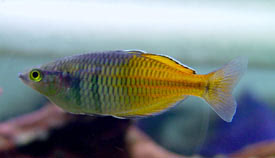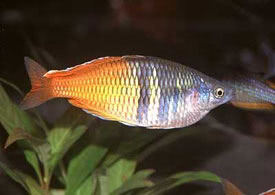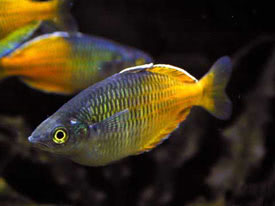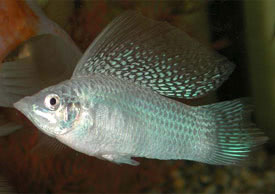
 Magyarul / Hungarian
Magyarul / Hungarian



- Scientific name: Melanotaenia boesemani
- Common name: Boeseman's rainbowfish
- Group: Rainbowfish
- Habitat: Asia; Indonesia
- Size: 8-10 cm
- Biotope: Inhabits shallow regions of dense vegetation in the Ajamaru Lakes in Irian Jaya
- Social behavior: An active, schooling species suitable for a community tank.
- Diet: Live, insect larvae, crustaceans, worms, insects, flakes
- Breeding: Easy
- Tank: Minimum 300 litres
- Population: 6 fishes for 300 litres
- Decoration: Use dense plating along the sides andback of the tank, and leave an open swimming area in the center.
- Temperature: 27-30°C
- pH: 7,5-8,5
- Hardness: 5,6-18NK°
- Lifespan: 5 years
Description: An elongated species with lateral compression. The rear edge of the caudal fin is concaveand there are two dorsal fins. Fish begin to develop their colors at 2.4" (6 cm) which intensifies with age. Thefront half of the body of the male is bluish with three transverse blue stripes. A lateral, blue stripe runs from themouth, through the eye, before fading near the caudal penuncle. The rear half of the body is orange-yellow. Femalesare less colorful. The first dorsal is blue-green while the second is yellow-orange with a blue and whiteborder. The caudal fin is yellow-orange as is the anal fin which may have a violet border.
Males are larger, higher backed, and more colorful with age.
Furnish the tank with Java Moss and fine-leaved plants. Place only the pair in the tank andraise the temperature to 75-81°F (24-27°C). A small number of eggs is laid daily for several months. The clear eggs ad here to plants with thin threads. These hatch after seven to eight days and are ignored by the parents. Theyoung first feed on roftiers, but later can be given egg yolk and Artemia nauplii. The young are very small and grow slowly. Start feeding with infusoria for thefirst week, followed by fine-grade dry food. After two weeks feed Artemia nauplii.




